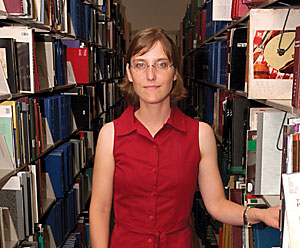 |
|
CHRIS CODUTO / Arizona Daily Wildcat
|
Britt Salvesen will join the Center for Creative Photography as a curator in October. Salvesen has worked for the Milwaukee Art Museum as the associate curator of prints for 2 1/2 years, and is looking forward to starting her new job at CCP.
|
|
|
By Kylee Dawson
Arizona Daily Wildcat
Thursday, August 26, 2004
Print this
Britt Salvesen canít wait to get her carefully gloved hands all over the bounty of photographic treasures stashed in the confines of the Center for Creative Photography.
Now that she has been hired as the CCPís new curator, sheíll finally get a chance to help make the best of the CCPís impressive collection.
Salvesen, who for two and a half years, has worked at the Milwaukee Art Museum as the associate curator of prints, drawings and photographs, will officially join the CCP in October.
Though Salvesen is an authority on both 19th century and contemporary photography, she is not a photographer herself.
ďIím probably more comfortable with a box camera than a digital camera,Ē she admits. However, Salvesen said she plans to use her husbandís digital camera to shoot Tucsonís beautiful scenery.
While visiting the UA campus on Monday, Salvesen took the time to speak with the Wildcat.
Wildcat: Because you specialize in both contemporary and historical photography, do you find it difficult to select a favorite time period or style of photography?
Salvesen: Oh yeah. It is difficult and my academic background is in the 19th century, but since then Iíve worked more on 20th century materials and contemporary materials, and I think thereís a very interesting continuum and lots of connections. Photographers are always looking at other pictures and tend to have a very sophisticated historical sense of their medium, and so I think working with contemporary photography is a great way to approach historical photography.
Wildcat: Have you studied in any other countries?
Salvesen: I did a junior year abroad in Spain. Thatís actually where I discovered art history. I was a Spanish major and did a year abroad ó which was a terrific experience ó and I had art history classes for the first time and I just knew, ďOkay, this is it!Ē And I kinda crammed in a major in my last year, so I ended up a double major.
Wildcat: Tell me about your new book ďThe History of Photography.Ē
Salvesen: Iím the co-editor with, actually, my thesis adviser at the University of Chicago. His name is Joel Snyder, and what we want to create is a selection of readings from the 19th century that can help trace the history of photography during that period and the language of the period. So itís not just a secondary summary, but the direct voices of that time. And so it includes very early descriptions of the early processes and when it was a very trial and error period for the invention of photography.
Wildcat: Film or digital?
Salvesen: (Laughs) I know this is going to sound like the glib answer, but I think thereís a place for both. As a curator, I see a lot of work of both kinds, and I can understand why photographers are excited about digital because itís a brand-new tool and has a lot of great capacities. When I look at the results, I always want to know, ďDid you choose the right tool for your expressive aim, or were you just excited by the novelty of it?Ē So, if thereís a good answer in the picture for which tools were used, then Iím fine with it. But I also donít want to see analog type things disappear out of new enthusiasm. I think itís worrisome when schools, art departments are closing their darkrooms and students are not using them. Printing is hard and itís an art and I would hate to see that lost.
Wildcat: Do you think photography is an art or a science?
Salvesen: Itís definitely both. Thatís what makes it an exciting area for me. And I think thatís what makes it so culturally important, because it has so many uses for one thing and applications, and therefore it can have so many different audiences.
Wildcat: Which do you think is more interesting: color or black and white?
Salvesen: Ö Lately Iíve been more interested in color from a couple of different perspectives. For one thing, Iím interested in how, from the beginning, from the very moment that photography was invented,
photographers wanted to make color pictures. And then in the 20th century, once it was achieved, it took a long time to accept it as an artistically valid component in photography. So itís this funny story of both desperately wanting it and then kind of rejecting it once it was possible to do.
Wildcat: What do you look forward to doing here as curator of the UA?
Salvesen: This is an exciting position for me, because it does allow me to specialize in photography and also be involved in the university community with students and researchers as well as other museum professionals. So I think itíll be a great community of people who are interesting in photography from a number of different angles.
